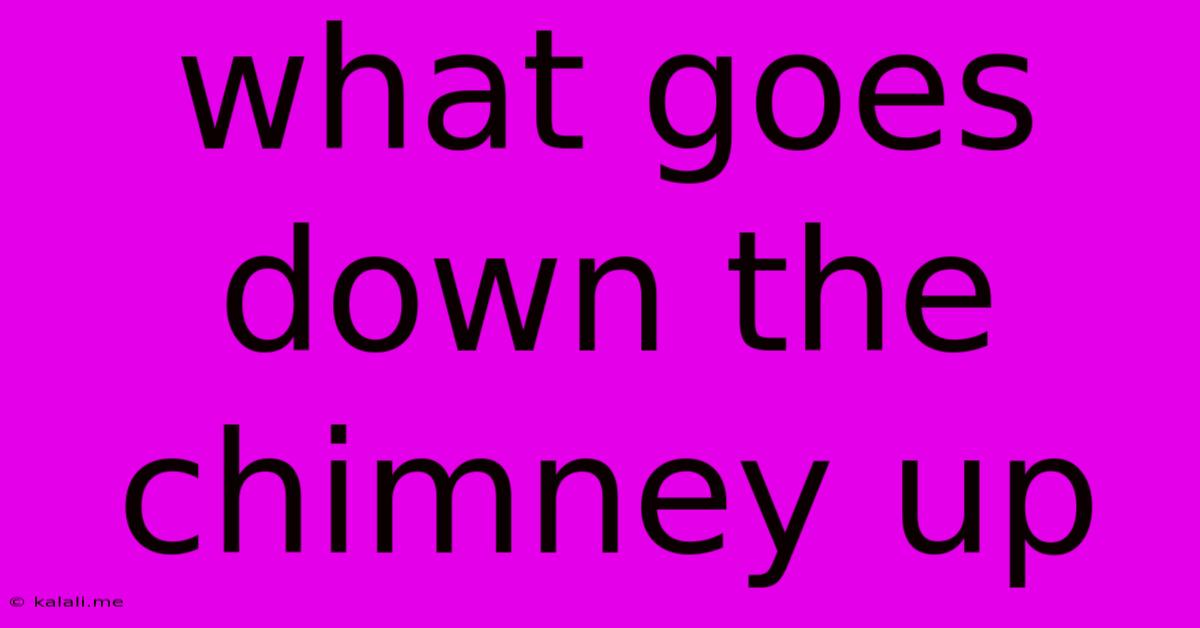What Goes Down The Chimney Up
Kalali
May 21, 2025 · 3 min read

Table of Contents
What Goes Down the Chimney Up? A Surprisingly Complex Question
This seemingly simple question, "What goes down the chimney up?", actually delves into the fascinating world of physics, particularly thermodynamics and the principles of convection and pressure. While the immediate answer might seem obvious (smoke, soot, etc.), a deeper exploration reveals a more nuanced understanding of chimney function and airflow.
The Simple Answer: Smoke and Combustion Byproducts
The most straightforward answer is that smoke and other combustion byproducts go down the chimney up. This includes gases like carbon dioxide and carbon monoxide, as well as particulate matter like soot and ash. These products are produced by the burning of fuel within a fireplace or stove. The heat generated by this combustion process creates a difference in pressure, driving the smoke upwards and out of the chimney.
The Physics Behind the Upward Flow:
The upward movement of smoke isn't simply gravity defying; it's a result of several interacting forces:
- Convection: Hot air is less dense than cold air. The heat from the fire heats the air inside the chimney, making it less dense and causing it to rise. This rising air creates a pressure difference, drawing in more air from below to replace it, continuing the cycle. This process is known as natural convection.
- Pressure Difference (Stack Effect): This is the difference in pressure between the inside and outside of the chimney. The warm air inside is lighter and creates a low-pressure area compared to the surrounding cooler air. This pressure difference pushes the smoke and gases upwards and out. The height of the chimney significantly influences this effect; taller chimneys have a stronger stack effect.
- Wind: External wind can impact the airflow in the chimney. While generally assisting the upward flow, strong winds can sometimes create downdrafts, potentially blowing smoke back down the chimney. This is a common problem with poorly designed or maintained chimneys.
Beyond Smoke: Other Chimney Inhabitants
While smoke is the primary occupant, several other things might find their way down the chimney, albeit unintentionally:
- Birds and small animals: Birds might nest in the chimney, and small animals might seek shelter within its confines.
- Debris: Leaves, twigs, and other debris can accumulate in the chimney, potentially hindering airflow or causing a fire hazard. Regular chimney sweeping is crucial to prevent this.
- Creosote: This flammable byproduct of wood combustion builds up inside chimneys, posing a significant fire risk. Creosote buildup is a serious concern and requires professional cleaning.
Understanding Chimney Functionality for Safety and Efficiency:
Understanding what goes down the chimney – and why – is vital for maintaining a safe and efficient fireplace or stove. Regular inspection and cleaning of your chimney are essential to prevent hazards such as creosote buildup, blockages, and the potential for chimney fires. A properly functioning chimney ensures the safe and complete removal of combustion byproducts, contributing to a healthy indoor environment. Consider consulting a chimney sweep for regular maintenance.
In conclusion, while the immediate answer is smoke and combustion byproducts, the process behind the upward movement involves a complex interplay of physics principles. Understanding this process is key to ensuring the safe and efficient operation of your chimney system.
Latest Posts
Latest Posts
-
When Was The Gospel Mark Written
May 21, 2025
-
Seek To Understand Before Being Understood
May 21, 2025
-
Tiktok Verification Code Email I Didnt Request
May 21, 2025
-
Cigarette Lighter In Car Does Not Work
May 21, 2025
-
Do Fleas Die In Washing Machine
May 21, 2025
Related Post
Thank you for visiting our website which covers about What Goes Down The Chimney Up . We hope the information provided has been useful to you. Feel free to contact us if you have any questions or need further assistance. See you next time and don't miss to bookmark.